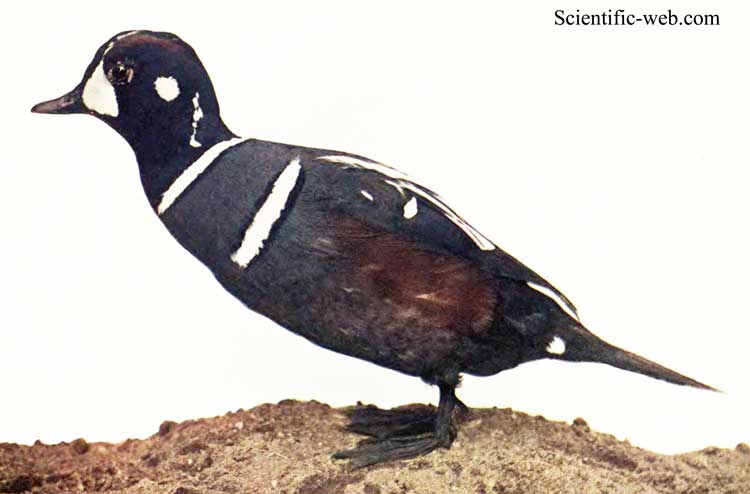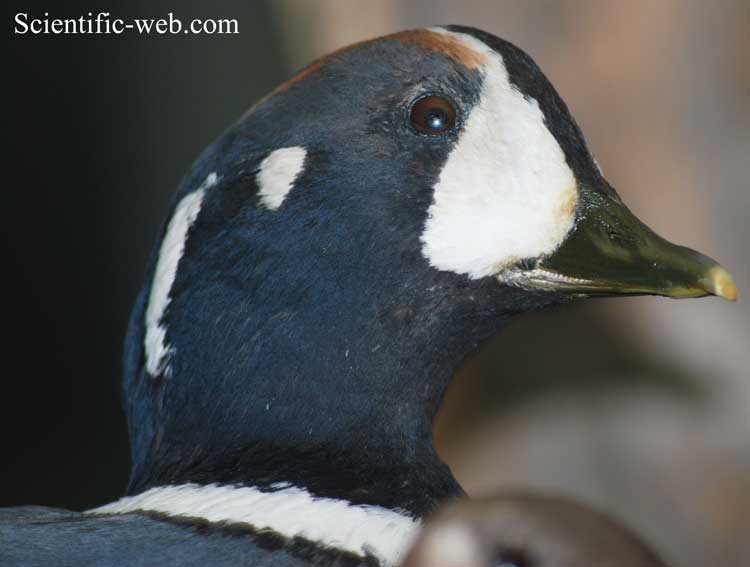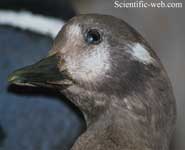
Histrionicus histrionicus
Superregnum: Eukaryota
Regnum: Animalia
Subregnum: Eumetazoa
Cladus: Bilateria
Cladus: Nephrozoa
Superphylum: Deuterostomia
Phylum: Chordata
Subphylum: Vertebrata
Infraphylum: Gnathostomata
Superclassis: Tetrapoda
Cladus: Reptiliomorpha
Cladus: Amniota
Classis: Reptilia
Cladus: Eureptilia
Cladus: Romeriida
Subclassis: Diapsida
Cladus: Sauria
Infraclassis: Archosauromorpha
Cladus: Crurotarsi
Divisio: Archosauria
Subsectio: Ornithodira
Subtaxon: Dinosauromorpha
Cladus: Dinosauria
Ordo: Saurischia
Cladus: Eusaurischia
Cladus: Theropoda
Cladus: Neotheropoda
Cladus: Averostra
Cladus: Tetanurae
Cladus: Avetheropoda
Cladus: Coelurosauria
Cladus: Maniraptoromorpha
Cladus: Maniraptoriformes
Cladus: Maniraptora
Cladus: Pennaraptora
Cladus: Eumaniraptora
Cladus: Avialae
Infraclassis: Aves
Cladus: Euavialae
Cladus: Avebrevicauda
Cladus: Pygostylia
Cladus: Ornithothoraces
Cladus: Euornithes
Cladus: Ornithuromorpha
Cladus: Ornithurae
Cladus: Carinatae
Parvclassis: Neornithes
Cohors: Neognathae
Cladus: Galloanseres
Ordo: Anseriformes
Familia: Anatidae
Subfamilia: Merginae
Genus: Histrionicus
Species: Histrionicus histrionicus
Name
Histrionicus histrionicus (Linnaeus, 1758)
Synonyms
Anas histrionica (protonym)
Anas minuta Linnaeus, 1758
References
Linnaeus, C. 1758. Systema Naturae per regna tria naturæ, secundum classes, ordines, genera, species, cum characteribus, differentiis, synonymis, locis, Tomus I. Editio decima, reformata. Holmiæ: impensis direct. Laurentii Salvii. i–ii, 1–824 pp DOI: 10.5962/bhl.title.542: 127. Reference page.
Vernacular names
azərbaycanca: Qayaördəyi
brezhoneg: Harlikin
català: Ànec arlequí
čeština: Kačka strakatá
Cymraeg: Hwyaden seithliw
dansk: Strømand
Deutsch: Kragenente
English: Harlequin Duck
Esperanto: Arlekenanaso
español: Pato arlequín
eesti: Kärestikuaul
euskara: Ahate arlekin
suomi: Virta-alli
føroyskt: Brimont
français: Arlequin plongeur
עברית: ברווז ארלקינו
magyar: Tarka réce
Iñupiak: Aahaaliġñaq
íslenska: Straumönd
italiano: Moretta arlecchina
日本語: シノリガモ
қазақша: Шақшақайша
한국어: 흰줄박이오리
lietuvių: Puošnioji antis
latviešu: Arlekīnpīle
Nederlands: Harlekijneend
norsk: Harlekinand
polski: Kamieniuszka
português: Pato-arlequim
rumantsch: Anda dal culier
русский: Каменушка
саха тыла: Уораныкы
slovenčina: Kamenárka strakatá
slovenščina: Harlekinka
српски / srpski: Арлекинка - Arlekinka
svenska: Strömand
Türkçe: Altıngöz
українська: Каменярка
中文: 丑鸭
The harlequin duck (Histrionicus histrionicus) is a small sea duck. It takes its name from Harlequin (French Arlequin, Italian Arlecchino), a colourfully dressed character in Commedia dell'arte. The species name comes from the Latin word "histrio", meaning "actor". In North America it is also known as lords and ladies. Other names include painted duck, totem pole duck, rock duck, glacier duck, mountain duck, white-eyed diver, squeaker and blue streak.
Taxonomy
In 1747 the English naturalist George Edwards included an illustration and a description of the harlequin duck in the second volume of his A Natural History of Uncommon Birds. He used the English name "The Dusky and Spotted Duck". Edwards based his hand-coloured etching on a preserved specimen that had been brought to London from Newfoundland in eastern Canada.[2] When in 1758 the Swedish naturalist Carl Linnaeus updated his Systema Naturae for the tenth edition, he placed the harlequin duck with the ducks, geese and swans in the genus Anas. Linnaeus included a brief description, coined the binomial name Anas histrionica and cited Edwards' work.[3] The harlequin duck is now the only species placed in the genus Histrionicus that was introduced in 1828 by the French naturalist René Lesson.[4][5] The species is monotypic: no subspecies are recognised.[5] The name histrionicus is from Latin and means "theatrical" or "like a harlequin" (histrio, harlequin means "actor").[6]
Two prehistoric harlequin ducks have been described from fossils, although both were initially placed in a distinct genus: Histrionicus shotwelli is known from Middle to Late Miocene deposits of Oregon, United States and was considered to form a distinct monotypic genus, Ocyplonessa. Histrionicus ceruttii, which lived in California during the Late Pliocene, was at first taken to be a species of the related genus Melanitta. The species is traditionally considered monotypic. The Eastern and Western populations are sometimes recognized as two different subspecies, the Eastern race being the nominate H. histrionicus histrionicus, and the Western race as H. h. pacificus, but there has been doubt on the validity of this taxon.
Description
A pair of males flanked by a pair of females
Adult breeding males have a colorful and complex plumage pattern. The head and neck are dark slate blue with a large white crescent marking in front of the eye that extends up to the crest, a small round dot behind the eye, and a larger oval spot down the side of the neck. A black crown stripe runs over the top of the head, with chestnut patches on either side. A black-bordered white collar separates the head from the breast. The body is largely a lighter slate blue with chestnut sides. A black-bordered white bar divides the breast vertically from the sides. The tail is black, long and pointed. The speculum is metallic blue. The inner secondary feathers are white and form white markings over the back when folded. The bill is blue-grey and the eye is reddish. Adult females are less colourful, with brownish-grey plumage with three white patches on the head: a round spot behind the eye, a larger patch from the eye to the bill and a small spot above the eye.[7]
Standard Measurements[7][8]
length 15–17 in (380–430 mm)
weight 600 g (1.3 lb)
wingspan 26 in (660 mm)
wing 188–202 mm (7.4–8.0 in)
tail 77–101.5 mm (3.03–4.00 in)
culmen 25–27 mm (0.98–1.06 in)
tarsus 36.5–38.5 mm (1.44–1.52 in)
Distribution and habitat
Eggs, Collection Museum Wiesbaden
Their breeding habitat is cold fast moving streams in north-western and north-eastern North America, Greenland, Iceland and eastern Russia. The nest is usually located in a well-concealed location on the ground near a stream. They are usually found near pounding surf and white water. They are short distance migrants and most winter near rocky shorelines on the Atlantic and Pacific coasts. They are very rare migrants to western Europe.
The eastern North American population is declining and is considered endangered. Possible causes include loss of habitat due to hydroelectric projects and loss of life due to oil spills near coastal areas.
Behaviour
These birds feed by swimming under water or diving. They also dabble. They eat molluscs, crustaceans and insects. Harlequins have smooth, densely packed feathers that trap a lot of air within them. This is vital for insulating such small bodies against the chilly waters they ply. It also makes them exceptionally buoyant, making them bounce like corks after dives.
Breeding
Harlequin ducks adhere to a monogamous mating system, during their winter mating season with form multi-year pair bonds, though the males rarely participate in paternal care. Young ducks begin courtship in their first winter, females will find success by the second year, yet the males will rarely form a persistent bond before their fourth winter. Harlequin males will have an alternate plumage during this winter mating season.
Both female and male harlequins exercise mate-choice preference and pair-bond defense, to demonstrate fidelity to their partner. Either partner is able to divorce the pair-bond to pursue a higher-quality option, however this behavior is uncommon.[9]
References
BirdLife International (2018). "Histrionicus histrionicus". IUCN Red List of Threatened Species. 2018: e.T22680423A132527785. doi:10.2305/IUCN.UK.2018-2.RLTS.T22680423A132527785.en. Retrieved 13 November 2021.
Edwards, George (1747). A Natural History of Uncommon Birds. Vol. Part II. London: Printed for the author at the College of Physicians. p. 99, Plate 99.
Linnaeus, Carl (1758). Systema Naturae per regna tria naturae, secundum classes, ordines, genera, species, cum characteribus, differentiis, synonymis, locis (in Latin). Vol. 1 (10th ed.). Holmiae (Stockholm): Laurentii Salvii. p. 127.
Lesson, René P. (1828). Manuel d'ornithologie, ou Description des genres et des principales espèces d'oiseaux (in French). Vol. 2. Paris: Roret. p. 415.
Gill, Frank; Donsker, David; Rasmussen, Pamela, eds. (July 2021). "Screamers, ducks, geese & swans". IOC World Bird List Version 11.2. International Ornithologists' Union. Retrieved 11 October 2021.
Jobling, James A. (2010). The Helm Dictionary of Scientific Bird Names. London: Christopher Helm. p. 193. ISBN 978-1-4081-2501-4.
Godfrey, W. Earl (1966). The Birds of Canada. Ottawa: National Museum of Canada. p. 73.
Sibley, David Allen (2000). The Sibley Guide to Birds. New York: Knopf. p. 97. ISBN 0-679-45122-6.
Rodway, Michael S. “Pair-Bond Defense Relates to Mate Quality in Harlequin Ducks (Histrionicus Histrionicus).” Waterbirds: The International Journal of Waterbird Biology, vol. 36, no. 2, 2013, pp. 189–198., www.jstor.org/stable/24641582. Accessed 18 Apr. 2020.
Retrieved from "http://en.wikipedia.org/"
All text is available under the terms of the GNU Free Documentation License



